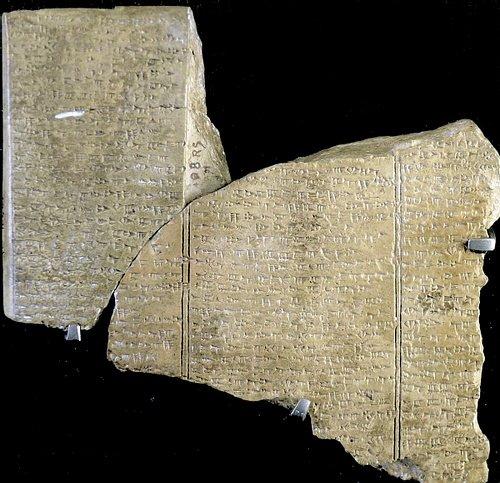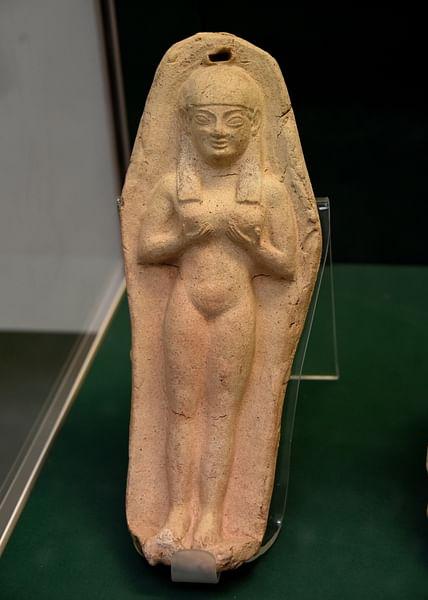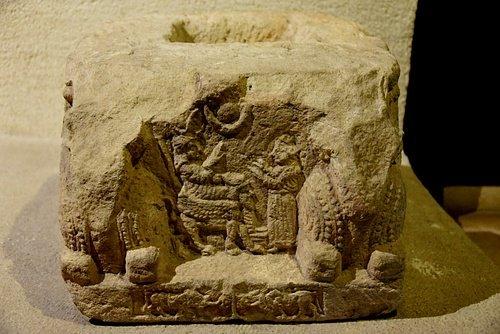Astarte is the Canaanite/Phoenician goddess of love, sex, war, and hunting who developed from the Mesopotamian deity Inanna/Ishtar. She is usually associated with the storm god Baal but seems to have been much more popular. She traveled to Egypt through trade where she was adopted as a war deity and consort of Set.
She was associated with war in the Levant prior to her arrival in Egypt, but stories concerning her usually emphasize her skill in hunting and aspects of her relationship with Baal and the god El. She is often depicted with horses and chariots after her arrival in Egypt and as a beautiful naked woman, sometimes with wings or horns, as she was in Canaanite/Phoenician regions which also associated her with the dove, bee, and lion.
She traveled from Phoenicia and then Egypt via trade throughout the Mediterranean and was clearly quite popular based on the number of temples raised in her honor. She is thought to have informed the development of the Greek goddesses Artemis and Aphrodite, the Roman Venus, as well as the Hurrian goddess Sauska, among others. Astarte is also known as Ashtart, Athart, and in the Bible as Ashtoreth, consort of Baal, and is condemned along with him as a "false god" by the prophet Elijah as well as others, including Jeremiah, for drawing people away from the worship of Yahweh.
Her name has been connected to the Christian holiday of Easter, though this claim is repeatedly challenged. It is possible, however, that she informed later fertility goddesses whose festivals were Christianized, as many pagan celebrations were. In the present day, she remains a popular goddess among the Neo-Pagan and Wiccan movements who regard her, along with other ancient goddesses, as a source of personal empowerment and inspiration.
Name & Origins
Astarte is the Greek form of the Canaanite Athart and the Phoenician Ashtart both of which derive from the Akkadian Asdartu referencing the goddess Ishtar. Ishtar developed from the Sumerian goddess Inanna who is attested in writing from the 4th millennium BCE but whose worship is understood as much older. Inanna was the goddess of love, sexuality, sensuality, fertility, and war, and these attributes later characterized Ishtar.
Inanna was already a popular goddess in Sumer when she was identified with Ishtar by Enheduanna (l. 2285-2250 BCE), high priestess of the temple at Ur and daughter of Sargon of Akkad (r. 2334-2279 BCE), founder of the Akkadian Empire. Sargon credits Ishtar for military victories in his inscriptions, identifying her as a war deity during his reign. Scholar Stephen Bertman describes the goddess:
Inanna or Inanna/Ishtar (West Semitic: Astarte) was the most popular deity of ancient Mesopotamia [who] represented the power of sexual attraction and the carnal pleasure that proceeds from it. Focused on the immediate gratification of her own sensual needs, she was neither a goddess of marriage nor of childbirth. Her sexual appetite was inexhaustible and her relationships with men short term…Because of her savagery and her fierce determination to have her own way whatever the cost to others, Inanna/Ishtar was also a goddess of war and a patroness of ruling dynasties. Her animal was the lion and her symbol the star, signifying the morning and evening star Venus, with whom she was astrologically identified. (120)
She was adopted with these attributes by the Canaanites who added the bee, dove, and palm tree to her iconography. Her characteristics, prior to her arrival in Egypt, have been interpreted by scholars primarily from statuary and reliefs as she plays a minor role in the tales of the Canaanite gods. Baal's sister, Anat, is far more well-defined in Canaanite religious literature while Astarte seems to have been in Egypt. The two goddesses were paired as cultic figures in Egypt, though recognized as different deities, and in Canaanite mythology, they appear together in at least two tales.
The Ugaritic Texts
Astarte is first mentioned in texts from the ancient city of Ugarit (modern-day Ras Shamra, Syria) dating back to the mid-14th to late 13th centuries BCE, specifically the Baal Cycle and El’s Drinking Party. The Baal Cycle is not a single work but a collection of tales concerning Baal's war with the sea god Yamm, his victory over death, and ascent as king of the gods.

Baal is the god of storms, rain, and war who was also associated with fertility and good harvests and was one of the more popular gods of the Canaanite pantheon. His power, and position as a prince, son of the Lord El, made him a natural choice as El's successor. The Baal Cycle opens, however, with Baal's disappointment at El's decision to choose Yamm as the new king instead of himself. Once Yamm is given the kingship, though, he enslaves his fellow gods who cry out to El's consort, Asherah, for help. Asherah offers Yamm various treasures if he will change his policy, but he refuses them, saying all he wants is to possess the queen. When Asherah returns to the council of the gods with this news and her acceptance of Yamm's condition, all gratefully accept her sacrifice on their part except Baal who swears he will kill Yamm.
When Yamm sends emissaries asking for the council to surrender Baal to him, the messengers behave arrogantly, and he moves to attack them but is restrained by Anat and Astarte:
Then Prince Baal was shaken
In his hand a striker,
In his left hand a slayer…
…Anat seizes,
His left hand Astarte seizes.(Tablet 2, Column 1; Coogan & Smith, 113)
The text is badly damaged at this point, but the goddesses seem to warn him against killing messengers who are only obeying orders. El also ignores the bad behavior of the emissaries and promises Baal will be delivered and will come bearing gifts. At this point, the god of crafts, Kothar-wa-Khasis, forges two mighty clubs for Baal that will defeat Yamm. Baal meets Yamm in single combat, defeats him, and throws him back into the sea, afterwards assuming the kingship.
Following this sequence, Mot, the god of death, rises in rebellion against Baal and swallows him (or thinks he does as Baal has actually gone into hiding and sent a double in his place). Since he is a fertility god, his absence brings drought and famine. It would seem natural, at this point, that his consort Astarte would play a significant role in avenging him, but instead, it is his sister Anat who kills Mot, cuts him into pieces, and hurls him throughout the land. Afterwards, Baal reveals himself and resumes his reign, subdues Mot (who, as an immortal god, has returned to life), and the story ends.

Astarte's role throughout is minor, and scholars Michael D. Coogan and Mark S. Smith explain this as an expression of Ugarit's patriarchal society which informed its theology (7). There is no doubt that Ugaritic patriarchy informed the religious texts, but this does not explain why Asherah and Anat are given central roles while a popular goddess like Astarte only appears in the scene where she helps restrain Baal and then later when she votes with the other gods that Baal should have his own palace.
The Baal Cycle was discovered at Ugarit in 1929, and early scholarship solved this problem by claiming Astarte and Anat were conflated and so it is, in fact, Astarte who takes on the role of avenger. This claim has been dismissed, however, as it is clear the two goddesses are distinct, and there is no evidence they were ever conflated. In the myth El’s Drinking Party, Anat and Astarte prepare the feast, go hunting together, and help El cure his hangover afterwards.
It is more likely that Anat is simply the more active agent of the two, choosing to take on the task herself, while Astarte may have been thought to inspire others to act for her. This would be in keeping with her origins as the Mesopotamian Inanna/Ishtar who repeatedly manipulates others to do her bidding. In The Epic of Gilgamesh, to give the most famous example, she calls on the Bull of Heaven to punish Gilgamesh after he has rejected her advances rather than dealing with the insult herself. It is possible, since the two goddesses were paired, that Anat was the active and Astarte the passive partner, at least before their arrival in Egypt.
Astarte in the Levant & Egypt
However she was portrayed in the texts, archaeological evidence attests to her popularity throughout the Levant. She was worshipped at Baalbek, Byblos, Sidon, and Tyre, and at Baalbek – the major center for Baal's cult – her shrines and temples outnumbered his. From the Levant, she traveled via trade to Cyprus, where she became equally popular, and the same paradigm is observed with Greece and Egypt.
She arrived in Egypt during the New Kingdom's 18th Dynasty (c. 1550-1292 BCE) and is referenced on the Sphinx Stela erected by Amenhotep II (r. 1427-1401 BCE) as being "well pleased" with his horsemanship. Along with Anat, who traveled with her, she was regarded as the divine protectress of the pharaoh in battle, specifically of his chariot and horses.

The tales of the Baal Cycle seem to have traveled with her, but according to scholar Richard H. Wilkinson, Astarte was given the role previously played by Anat:
According to the fragmentary 19th dynasty story of Astarte and the Sea, the goddess seems to have been involved in thwarting the demands of the tyrannical sea god Yamm, though the details of this myth are lost to us. (138)
She was understood as the daughter of Ra (or perhaps Ptah) and consort of Set along with Anat. Her association with Set was explained through the popular tale The Contendings of Horus and Set, an account of the struggle of the two gods for kingship. The backstory of the action is the Osiris-Set cycle in which the rightful king, Osiris, is murdered by his jealous brother, Set, revived by his sister-wife Isis and her sister Nephthys, but because he is incomplete after his resurrection, he descends to the underworld to become Judge of the Dead. Isis raises their son Horus to maturity, at which point he challenges Set for the throne.
In The Contendings of Horus and Set, Horus and Set appear before the council of the gods to make their cases for kingship, and it is decided they should resolve their differences through a series of contests. Most of the gods feel that Horus should rule as he is the son of Osiris, but Ra feels he is too young and inexperienced and that Set has the maturity to make a better king. The contests go on for 80 years until Isis intervenes and Ra is convinced, awarding the kingship to Horus.
Set was still regarded as an effective monarch, however, and so was given control of the foreign lands beyond Egypt's borders and the barren regions of the desert. As a consolation prize, since it was acknowledged these lands could not compare with the beauty of Egypt, he was also given Anat and Astarte as consorts. Although Set had lost the kingship and was portrayed as the villain in the Osiris-Set cycle, he was also worshipped during the New Kingdom of Egypt, and Astarte's popularity certainly did not suffer from her association with him. She was worshipped throughout Egypt in formal temples dedicated to her, at shrines, paired with Anat, and as a member of triads, appearing with Mut and Khonsu. Wilkinson comments:
She appears as a war goddess [in Egypt] and while the sexual aspect of Astarte does not seem to have been as pronounced in Egyptian religion as in her Canaanite homeland, it was probably not entirely absent in her Egyptian mythology. She was usually portrayed as a naked woman on horseback brandishing weapons and wearing an Atef crown or a headdress with bull's horns…A number of depictions of an otherwise unidentified goddess wearing a horned helmet – as on ostraca found at the workmen's village of Deir el-Medina – may well represent this goddess. (138-139)
She was appealed to, along with Anat, for healing, protection, and victory in battle, especially concerning horses and chariots.
Astarte in the Bible
Astarte continued as a popular deity in the Levant and elsewhere and, according to the Bible, was a significant obstacle to the acceptance of the god Yahweh in the Kingdom of Israel. She is referred to as Ashtoreth in the biblical narratives and condemned as a false god by the prophets of Yahweh in I and II Kings, Jeremiah, and elsewhere. The Bible also references her by her epithet Queen of Heaven, which she inherited from Inanna/Ishtar, and makes clear how popular she was in a passage from the Book of Jeremiah.

After the prophet Jeremiah has told the people that Yahweh would destroy them unless they humble themselves, reject other gods, and worship him alone, the people reject his warnings, claiming their lives were better when they worshipped the goddess:
Then all the men who knew that their wives were burning incense to other gods, along with all the women who were present…said to Jeremiah, "We will not listen to the message you have spoken to us in the name of the Lord! We will certainly do everything we said we would: We will burn incense to the Queen of Heaven and will pour out drink offerings to her just as we and our ancestors, our kings and our officials, did in the towns of Judah and in the streets of Jerusalem. At that time, we had plenty of food and were well off and suffered no harm. But ever since we stopped burning incense to the Queen of Heaven and pouring out drink offerings to her, we have had nothing and have been perishing by sword and famine." (Jeremiah 44:15-18)
Jeremiah responds by telling them that their problems are all being caused by the worship of false gods like Astarte and, if they persist, Yahweh will punish them severely. The struggle between the cult of Baal/Astarte and that of Yahweh serves as the plot device to show Yahweh's superiority here as well as in the famous story of the prophet Elijah's contest with the priests of Baal in I Kings 18-19.
Conclusion
Elijah's war on the foreign gods forms the basis for his struggle against the Phoenician queen Jezebel, who encourages the worship of Baal and Astarte in Israel. Jezebel, like the goddess she worshipped, is presented as a villain in the Hebrew Scriptures and continued to be understood in this role once these became the Old Testament of the Christian Bible.

Although Astarte is often confused with Asherah in biblical commentary, the two were distinct goddesses, and the Asherah referenced in the Bible is the fertility pole (or sacred tree) of the goddess, not an allusion to Astarte, though some translations of the Bible seem to suggest this. Astarte continued to be villainized throughout the early development of Christianity and was understood as a representative of pagan belief systems who should be rejected.
By the Middle Ages, Astarte, like Baal, was associated with the Christian devil and was transformed in medieval works on demonology into the male demon Astaroth, part of an evil trinity with Beelzebub (derived from Baal) and Lucifer. Among certain Christian denominations in the present day, Astaroth continues to be understood in this same role, while Astarte is dismissed as an ancient false goddess whose clergy were defeated by the power of Yahweh. Modern Neo-Pagan and Wiccan adherents, however, counter this claim in continuing to venerate the goddess as she was honored in the past, finding in her a source of strength and personal empowerment.
